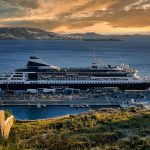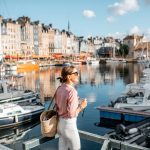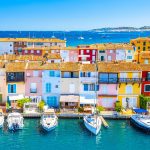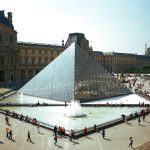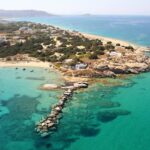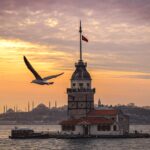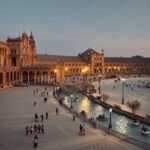Rhodes Island
The island of the Knights
Welcome to Rhodes, the capital of the Dodecanese, an island which is ideal not only for those who want to relax but also for those looking for an action-packed holiday! With its bright green hills, rich green valleys and uninterrupted line of golden beaches, Rhodes is truly a blessed place. Add in the excellent facilities for tourism, the island’s special blend of cosmopolitan and traditional, and numerous cultural and archaeological sites and you’ve got the perfect holiday destination. Rhodes Island is not just a destination for sun, sand and sea holidays, The visitor cannot ignore the magic of the history and mythology which has formed so much of present day civilization. At the crossroads of civilizations through its history, the island has a richly fascinating heritage.
Thanks to its strategic position, Rhodes has been important since ancient times. The ancient city of Rhodes, the construction of which began in 407 BC, was designed according to the city planning system devised by the greatest city planner of antiquity, Hippodamus of Miletus. Rhodes soon developed into one of the most important seafaring and trading centres in the Eastern Mediterranean. When it became a province of the Roman, and later the Byzantine Empire, it initially lost its ancient glory. But in 1309 the Knights of Saint John of Jerusalem conquered Rhodes. They built strong fortifications to protect the island, turning it into an important administrative centre and a thriving multinational medieval city. In 1523 Rhodes was conquered by the Ottoman Turks, and the Greeks had to settle outside the city walls. During the Ottoman occupation, new buildings were erected within the Old Town, mainly mosques and baths. In 1912 Rhodes and the rest of the Dodecanese, were seized by the Italians. The new rulers embellished the city with magnificent buildings, wide roads and squares. The Palace of the Grand Master was rebuilt and the Street of the Knights was reconstructed in order to regain its medieval purity. It was not until 1948 that Rhodes officially became part of Greece. In 1988 the Medieval City of Rhodes was listed as a UNESCO World Heritage site.
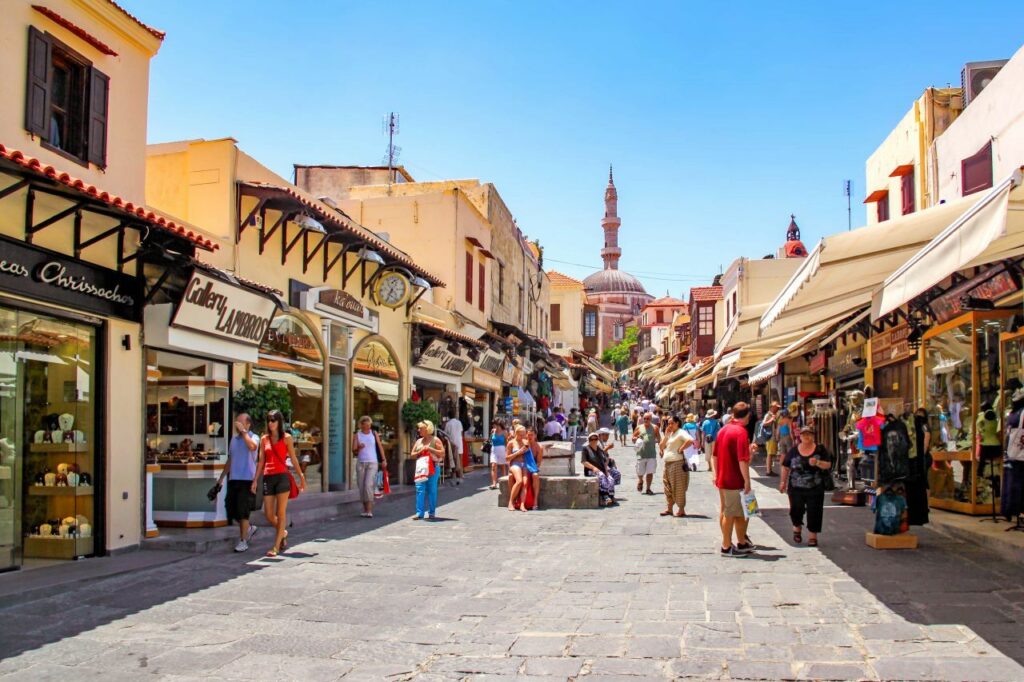
Walk through the city of Rhodes
The Old (medieval) City with narrow alleys, small houses and imposing knightly buildings surrounded by some 200 medieval churches. After the arrival of Knights Hospitaller of the Order of St. John in 1309, the fortification was extended, since the size of the city was four times bigger in relation to the Byzantine period. Therefore, new fortifications were constructed, which defined three main defense lines, with the last one being the fortress complex of the Great Magistrate’s Palace. There was an inside defensive line (wall) between the Palace and the ring wall dividing the city into two uneven parts.
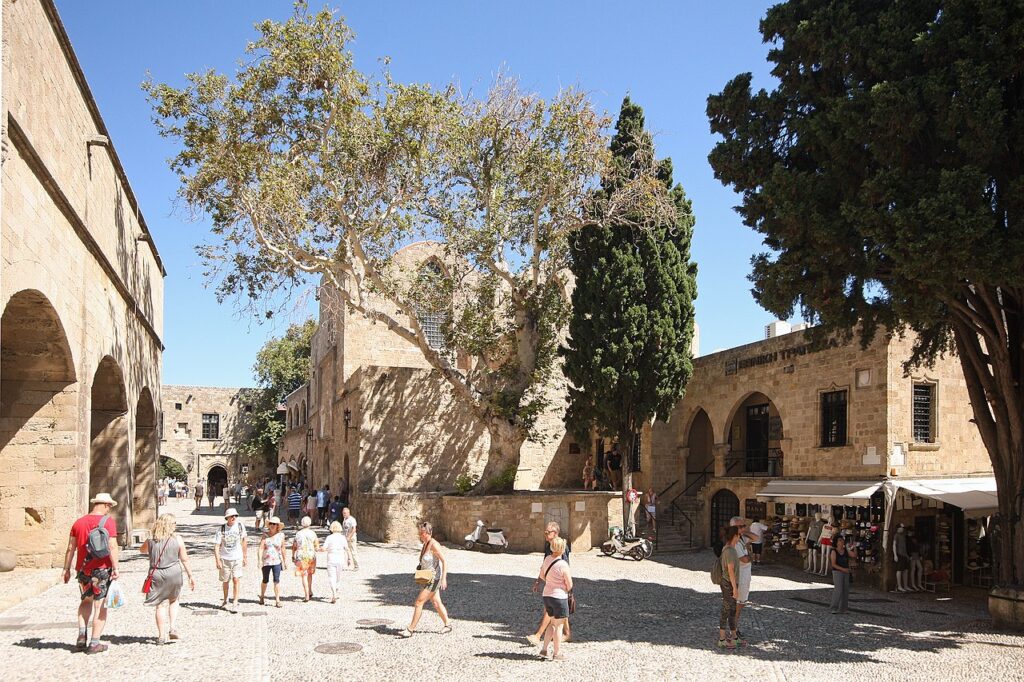
The north and smallest part was called Kollakio and was destined exclusively for the activities of the Knights. The Street of Knights was its main axis, beginning from the Great Magistrate’s Palace and ending at the church of Panagia tou Kastrou [Castle’s Virgin Mary]. The rest of the population resided at Bourgo. The walls surrounding the medieval city have a 4km perimeter and numerous towers and bastions. They consist of bridges, moats, bastions, towers and many decorative elements (coats of arms etc). Apart from the knightly buildings there are also distinguishing mosques with minarets reminding of the Turkish occupation era. The Medieval City can be accessed via eleven important gates, with the most famous one being Thalassini Pyli [Sea Gate]. The famous Street of the Knights, currently restored, in order to take the shape it had during medieval age. Along this street reside the “languages”, namely the national groups comprising the Order of the Knights of St. John.
The Palace of the Grand Master (14th century), also called “Castello”, by the local people. This was one of the first buildings constructed by the knights (completed in 1346). In 1856 it was completely destroyed from an accidental explosion, and was not restored until 1939, from the Italian patron of Dodecanese, Mariο de Vecchi.
The Archaeological Museum. It is situated in the Knights Hospital (15th century), in the Old City and hosts some important findings of the island, which cover a period from archaic to roman times.
Hippocrates Square. This is the starting point of two of the most central streets of the Old City: Aristotelous St., leading east to the square or Jews Martyrs and Sokratous St., the busy street of the old market. On the top of Sokratous St. is the Suleimanie mosque, built by Sultan Suleiman right after conquering Rhodes. There is a clock-tower built by Fechti Pasha in 1857 on the meeting point of Sokratous and Orpheus streets, today it has become a bar. You may admire the view of the Old City and take wonderful pictures from the castle top.
The Byzantine Museum, which is located in Panagia tis Nikis (Old City) and has frescos and icons from the late-Byzantine and post-Byzantine era.
Madraki, the area of the small port, where you can admire the imposing buildings of the Italian occupation era, currently hosting public services, the Municipal Theatre, and the New Market. It is worth visiting the complex of Governor House (today’s prefecture), the church of Agios Ioannis (today the church of Evangelismos), the lighthouse of Agios Nikolaos (1464-1467), the three medieval windmills at the edge of the pier, as well as the shrine of Murat Reis (16th century )

Visit the famous casino, located in the historical “Hotel of the Roses [Hotel des Roses]” (1927). The aquarium (built by the Italians in the period 1934-1936) is worth visiting as you can see the local marine life and spend your day in a delightful way with your family. The hill of Agios Stephanos or Monte Smith, the acropolis of ancient Rhodes, where you can also see the temple of Pallas Athena (Poliada) and Zeus Polieos, Nymphaia where underground cave formations are located, the conservatorium with an 800 – seat capacity, and the temple of Apollo Pythios. Make a point of visiting the modern part of the city that features luxury villas and edifices from where you can enjoy a marvelous sunset. Yeni Hamam was built in the late 16th c. Its name means New Hamam and it is still in use in contradiction to Eshki (old) Hamam, which is now deserted. The Municipal Gallery is located in Symi square in a renovated medieval building. Inside you can see engravings (16th – 20th centuries) as well as a Collection of Maps. Many periodical exhibitions are organized here. The Decorative Arts Collection of Rhodes is housed in the Hospitaller period building known as the Arsenal, on Argyrokastro Square. In the Center of Modern Art you’ll see works of contemporary Greek and foreign artists residing in Rhodes. Nestorideio Melathro is the New Art Gallery of the Modern Greek Art Museum of Rhodes, where the works of Greek painters and sculptors of 19th and 20th centuries are on display. Take your kids for a walk around Rodini Park (3 km S) there are fountains and a zoo to keep your little ones happy!
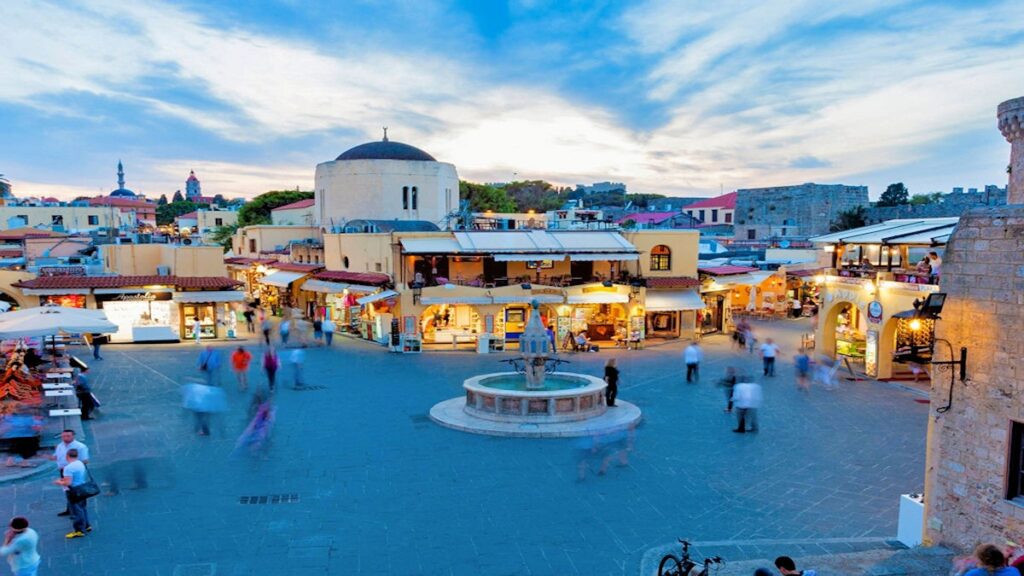
Places to visit
Lindos
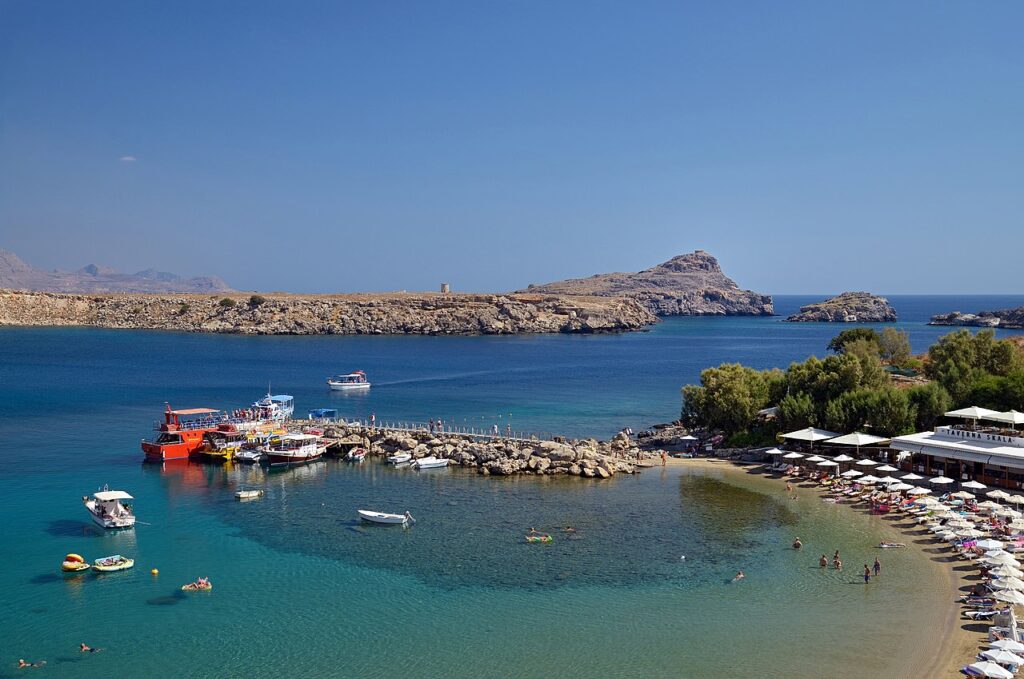
Here the medieval village has been preserved. It is built amphitheatrically at the foot of the rock and is dominated by the acropolis of Lindos. The most , important monuments on the archaeological site are: the temple of the Lindian Athena, the great Doric stoa, the Byzantine church of Saint John, the monumental staircase and the propylea.
Kamiros
It is built amphitheatrically on a hill with an acropolis on its crest. Here, remains of the foundations of temples can be seen, as well as private houses, bases with inscriptions, altars, etc.
Filerimos
On a plateau of the mountain of Filerimos, stand the ruins of the acropolis of ancient Ialyssos, the remains of the foundations of temples, a cruciform baptistery, the Monastery of Our Lady of Filerimos, the Byzantine church of Saint George of Hostos and the “Via Dolorosa” with its fourteen bronze plaques. The Valley of the Butterflies: This is a unique natural park, where, every year between June and September, thousands of butterflies congregate, live and reproduce, providing a magical spectacle.
Profitis Ilias
An enchanting site at an altitude of 650 metres, with a monastery amid the luxuriant vegetation, and a marvellous view.
Epta Piges
The “Seven Springs (Epta Piges)” flow among shady plane trees and rich vegetation. In the inland areas of the island there are also many charming villages: Psinthos, Dimylia, Eleousa, Salakos, Embonas, Archangelos, Siana, Laerma, Profilia, Apolakkia, Mesanagros, Kattavia
Rhodes Town
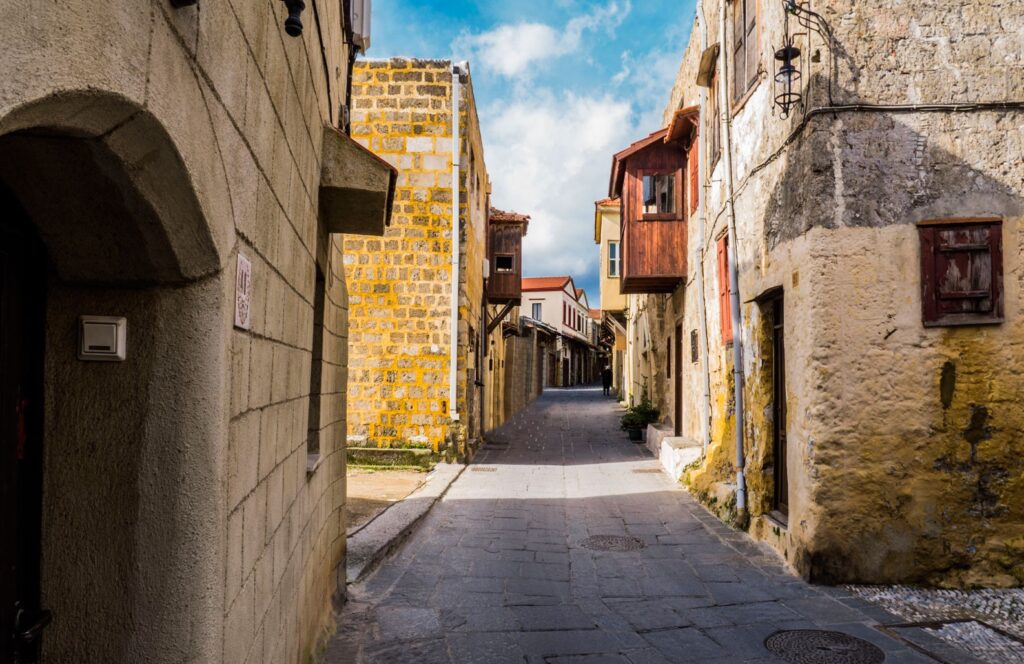 The capital, also called Rhodes, occupies the northernmost tip of the island. There are actually three cities on this site –modern, ancient and medieval. The modern town has a cosmopolitan character, many late 20th century buildings and hotels. The ancient town, which was founded in 408 B.C. according to plans by Hippodamos of Milesios (the first town planner), started from Monte Smith hill where the acropolis stood and extended as far as what is now the medieval city . All that is left of it today is the ruins of the temples of Zeus, Athena Poliados and Apollo, the Stadium, Gymnasium and the Theatre, which has been restored. The medieval city is still surrounded by the high walls erected by the Knights. It is divided by an inner wall into two unequal parts, the smaller Collachio and the larger Burgo or Hora.
The capital, also called Rhodes, occupies the northernmost tip of the island. There are actually three cities on this site –modern, ancient and medieval. The modern town has a cosmopolitan character, many late 20th century buildings and hotels. The ancient town, which was founded in 408 B.C. according to plans by Hippodamos of Milesios (the first town planner), started from Monte Smith hill where the acropolis stood and extended as far as what is now the medieval city . All that is left of it today is the ruins of the temples of Zeus, Athena Poliados and Apollo, the Stadium, Gymnasium and the Theatre, which has been restored. The medieval city is still surrounded by the high walls erected by the Knights. It is divided by an inner wall into two unequal parts, the smaller Collachio and the larger Burgo or Hora.
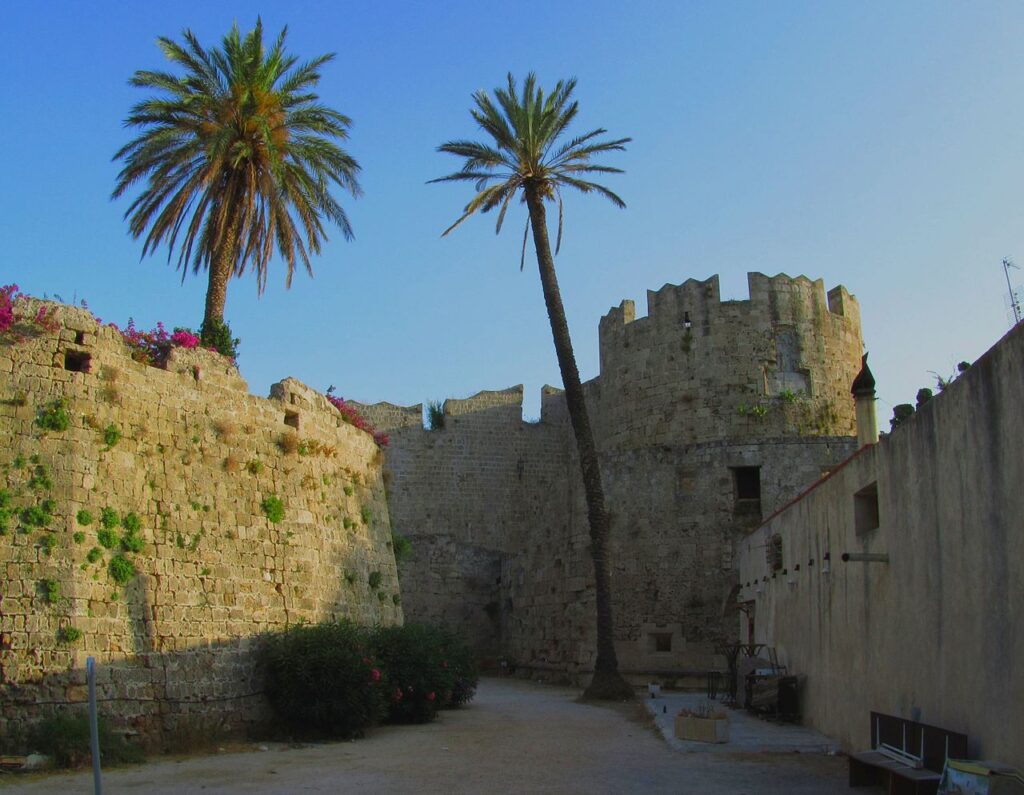
Collachio is further split by the Street of the Knights, both of whose sides are lined with the sombre stone facades of the Inns of the Tongues or nationalities that belonged to the order of the Knights Hospitalers of St. John. At the end of the street stands the palace of the Grand Masters, which today houses a collection of 16th and 17th century furniture and Roman mosaic floors from Kos. The Hospital of the Knights, another of the town’s most magnificent buildings, has been converted to the Archaeological Museum. Burgo / Hora lies to the south of Collachio; its walls once enclosed the humbler residences, the marketplace, the Synagogue and Jewish quarter, Orthodox and Catholic churches, public buildings and army barracks.
Afandou
Very popular resort with beautiful pebble beach and watersport facilities. Next to the beach is the golf course with 18 holes. South of Afandou is Kolymbia, with nice beach and good tourism infrastructure.
Pastida
Pastida lies 15 km north of Rhodes town and 7 km from the popular resort of Ialyssos. It is close to the airport. Pastida distinguishes for its authenticity and traditional character and consists of by whitewashed houses, paved alleys and a picturesque square. The surrounding region is covered with olive groves and vast vegetation. Pastida is a calm village with a tranquil atmosphere, an ideal destination to escape from the noisy crowds. With few population, Pastida has restaurants and taverns where homemade dishes are offered. Although it has easy access to the town of Rhodes and many beach resorts, still Pastida remains a peaceful destination. The village is offered for a short trip where you can wander the paved streets and the close nature, or for calm alternative holidays on the island. There are local buses connecting Pastida to Rhodes Town and other surrounding places.
Bee Museum of Rhodes : There’s a handful of apiculture museums across the world, but the Bee Museum in Rhodes is a unique one. Decorated with honeycomb-shaped ceilings, the museum is bathed in honey-colored lighting, sure to make Winnie-the-Pooh hungry. The Bee Museum of Rhodes was established by N. Melissourgos, CEO of the Dodecanese Beekeeping company. It is dedicated to the tradition and history of beekeeping in Rhodes, as well as the biology of bees, exhibiting transparent beehives for observation and a number of honey-related products. Located in the settlement of Pastida, this is a one-of-a-kind museum dedicated to bees and it consists of two different sectors. They are all well connected and combined, of course. First, the history of bees over the centuries. Where are they first documented in scripts and when was their value first recognized and acknowledged? Next section is all about bee products. Not only honey (Greek honey ranks among the finest in the entire world), but also pollen and various treats, enjoyed ever since antiquity. Honey and pollination, along with the biology of bees, complete the tour in an experience that you will cherish for a lifetime.
Faliraki
Faliraki’s claim to fame is without a doubt its magnificent soft and well organised sandy beach. Watersports action invites strong competition and caters from the novice to the most extrovert enthusiast. Faliraki’s high street truly comes alive as the sun goes down attracting tourists and locals in scores of bars, snack-bars, restaurants, tavernstaverns, discos and clubs. Water Park at Faliraki is an extensive entertainment complex that offers food, beverage, water slides, gym. In Faliraki area are four more beaches; Kathara bay -maybe the most attractive- which combines a sandy beach with steep rocks, Antony Quinn bay, Ladiko beach and Tragano beach with pebbles.
Kalythies village
(2 Km away from Faliraki) with tiny streets and alleys is worth a visit, where the panoramic view from Stavros church is beautiful. Places to visit include the church of Saint George with frescoes from post-byzantine period, Prifiti Ammo church which is built on the ruins of an older church, the monastery of Eleoussa with frescoes since 1871 and the cross shaped church of Ioannis Baptistis with frescoes since byzantine and post-byzantine period. Golfers will enjoy the superb golf course -18 holes- at Afandou, about 5 Km away.
Ialyssos (or Trianda)
Ialyssos was settled by Minoans in 1600 BC and may have been damaged in the explosions and tidal waves from Santorini. Today is a lively village and cultural tradition at the north west side of the island. The byzantine church of Saint Nikolas with frescoes since 15 AD is worth a visit. Trianda near the site of ancient Ialyssos on the top of Filerimos hill, where the 15th century monastery of the same name also stands, along with the ruined temples of Athena and Zeus Poliea in the ancient acropolis.
Ixia
It the ideal holiday resort of Ialyssos Prefecture with a wide range of accommodation from simple ones to top rated complexes. Ixia is an excellent choice for wind surfing with schools available and boats for hire are also available. It stretches with beautiful shingle beach.
Kalathos
With a small selection of taverns and bars on its main road, Kalathos is an unpretentious little village perfect for those seeking an uncrowded shingle beach and a quiet, easy going ambience. You’ll be only 10 minutes drive from Lindos when you feel the urge for a seriously good night out!
Kalithea
It is a great place to swim and snorkel. It has a tiny cove with bathing from rocks and the main interest is the thermal spa.
Kamiros
Kamiros was one of Rhodes’ three Dorian cities destroyed by an earthquake in 2 BC. To day are the ruins of the Dorian city where the temple base and the huge water cistern remain. Further south is Kamiros Skala, a tiny port for travelling to nearby Halki Island.
Lindos
Superb beaches, white-washed houses clinging to the hillside, ancient ruins of an Acropolis. A brilliant contrast, one of the most stunning views in Greece. Not many holiday resorts present such a stunning visual impact. Lindos is a maze of narrow cobbled streets with a terrific choice of lovely shops, bars, restaurants and clubs. Good beaches include the main bay, Pallas Beach and St Paul’s Bay. The temple of Athena Lindia (4th century B.C.) coming gradually into view as you ascend the stairs is a sight never to be forgotten.
Pefkos
Pefkos has become a popular holiday destination in its own right. Pleasantly tranquil off-season, it offers everything the visitor needs in terms of supermarkets, bars, taverns and souvenir shops. A fine choice for lazy days on the main sandy beach or one of the smaller bays and rocky coves followed by relaxing evenings at a nearby taverna.
Petaloudes
The Valley of the Butterflies. From June to September tiger moths (black and white striped) flock attracted by the sweet vanilla resin of the storax tree. A trail leads to the Monastery of Panagia Kalopetra and the Monastery of Ag. Soulas
Prasonissi
An island connected to Rhodes by a narrow sandy isthmus. The tiny island of Prasonissi at the southern seashore of the island is an ideal place for wind surfing lovers. The east side beach is usually calm, in contrast with the west side which is usually windy.
How to go to Rhodes island?
Summer seems to last forever on Rhodes, the largest and greenest of the Dodecanese islands. The tranquil beaches, the simple pleasures of a slower pace of life and the rejuvenating properties of fresh air, sparkling, refreshing seas and the Mediterranean diet make it the perfect location for relaxing and memorable holidays.
Ferries:
There are adequate schedules from Marmaris Turkey (the closest point). Rhodes is also connected with Patmos, Leros, Kalymnos, Kos, Halki, Symi, Kastellorizo, Nissyros, Karpathos, Kassos, Samos, Astypalaia, Crete, Santorini.
Use our Search Engine to find our best ferry deals
By Air:
There are flights from Athens and Thessaloniki (Salonica) operated by Olympic Airways and Aegean Airlines. Rhodes is also connected with Kastellorizo, Karpathos, Mykonos, Santorini, Heraklion (Crete).
Getting Around
There is frequent bus service between Rhodes Town (the capital) and the villages of the island. Car, motorbike rentals and taxis are plentiful.
Best Mini Rhodes Vacation Package, from 195US$ pp
Click here to see our Rhodes Island Short break package


